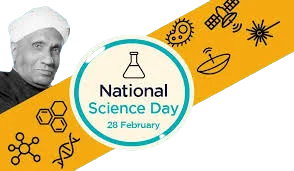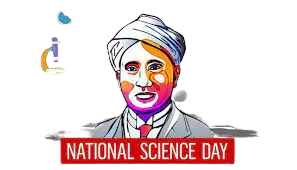India celebrates National Science Day every year on 28th February.
NATIONAL SCIENCE DAY
National Science Day is celebrated in honour of Indian physicist Sir Chandrasekhara Venkata Raman ( C.V. Raman ) for his Nobel Prize-winning discovery of the Raman Effect. For this discovery Sir C.V. Raman was awarded the Nobel Prize in Physics in 1930.

The event is now celebrated all over India in schools, colleges, universities and other academic, scientific, technical, medical and research institutions.
The celebration also includes public speeches, radio, TV, science movies, science exhibitions based on themes and concepts, debates, quiz competitions, lectures, science model exhibitions and many more activities.
National Science Day is celebrated to spread a message about the importance of science used in the daily life of the people. To display all the activities, efforts and achievements in the field of science for human welfare. It is celebrated to discuss all the issues and implement new technologies for the development in the field of science. To give an opportunity to the scientific minded citizens in India. To encourage the people as well as popularize science and technology.
The theme for National science Day celebrated on 28th February 2023 is “Global Science for Global Wellbeing”.
THEMES OF NATIONAL SCIENCE DAY
The theme of the year 1999 was “Our Changing Earth”.
The theme of the year 2000 was “Recreating Interest in Basic Science”.
The theme of the year 2001 was “Information Technology for Science Education”.
The theme of the year 2002 was “Wealth From Waste”.
The theme of the year 2003 was “50 years of DNA & 25 years of IVF – The Blue print of Life”.
The theme of the year 2004 was “Encouraging Scientific Awareness in Community”.
The theme of the year 2005 was “Celebrating Physics”.
The theme of the year 2006 was “Nurture Nature for our future”.
The theme of the year 2007 was “More Crop Per Drop”.
The theme of the year 2008 was “Understanding the Planet Earth”.
The theme of the year 2009 was “Expanding Horizons of Science”.
The theme of the year 2010 was “Gender Equity, Science & Technology for Sustainable Development”.
The theme of the year 2011 was “Chemistry in Daily Life”.
The theme of the year 2012 was “Clean Energy Options and Nuclear Safety”.
The theme of the year 2013 was “Genetically Modified Crops and Food Security”.
The theme of the year 2014 was “Fostering Scientific Temper”.
The theme of the year 2015 was “Science for Nation Building”.
The theme of the year 2016 was on “Scientific Issues for Development of the Nation”.
The theme of the year 2017 was “Science and Technology for Specially Abled Persons”
The theme of the year 2018 was “Science and Technology for a sustainable future.”
The theme of the year 2019 was “Science for the People, and the People for Science”
The theme of the year 2020 was “Women in Science.”
The theme of the year 2021 was ‘Future of STI: Impact on Education Skills and Work’.
The theme for NSD of the year 2022 is ‘Integrated Approach in S&T for Sustainable Future.
In 1986, the National Council for Science and Technology Communication (NCSTC) asked the Government of India to designate February 28 as National Science Day. The event is now celebrated all over India in schools, colleges, universities and other academic, scientific, technical, medical and research institutions.
C.V. Raman. On a boat trip back from England in 1921, Indian physicist C.V. Raman, considering the question of why the sea is blue, got started on a line of research that would lead to the discovery in February 1928 of a new scattering effect, now known as the Raman effect, which is important in physics and chemistry.
RAMAN EFFECT
Click here To know more about Raman Effect Raman Effect refers to the phenomenon in which when a stream of light passes through a liquid, a fraction of the light scattered by the liquid is of a different colour. This happens due to the change in the wavelength of light that occurs when a light beam is deflected by molecules.

Today, this method has a wide variety of applications, from studying art and other objects of cultural importance in a non-invasive fashion to finding drugs hidden inside luggage at customs.
NOBEL PRIZE PHYSICS
Physics was the prize area which Alfred Nobel mentioned first in his will from 1895. At the end of the nineteenth century, many people considered physics as the foremost of the sciences, and perhaps Nobel saw it this way as well. His own research was also closely tied to physics.
The Nobel Prize in Physics is awarded by the Royal Swedish Academy of Sciences, Stockholm, Sweden.
The Nobel Prize in Physics is a yearly award given by the Royal Swedish Academy of Sciences for those who have made the most outstanding contributions for humankind in the field of physics. It is one of the five Nobel Prizes established by the will of Alfred Nobel in 1895 and awarded since 1901, the others being the Nobel Prize in Chemistry, Nobel Prize in Literature, Nobel Peace Prize, and Nobel Prize in Physiology or Medicine. Physics is traditionally the first award presented in the Nobel Prize ceremony.
The first Nobel Prize in Physics was awarded to German physicist Wilhelm Rontgen in recognition of the extraordinary services he rendered by the discovery of X-rays. This award is administered by the Nobel Foundation and is widely regarded as the most prestigious award that a scientist can receive in physics. It is presented in Stockholm at an annual ceremony on 10 December, the anniversary of Nobel’s death. As of 2022 a total of 221 individuals have been awarded the prize.
The Nobel Prize is awarded in six categories each year — Physics, Chemistry, Medicine, Literature, Economics, and Peace Prize. Each Nobel Prize comes with SEK 9,000,000 (Swedish Krona) or around Rs 7 crore 22 lakh rupees.
Personal Life
Date of Birth – 7 November, 1888
Place of Birth – Thiruvanaikaval, Tamilnadu, India
Education – Presidency College, Chennai and University of Madras. He was a great researcher in field of Physics.
Institutions Established – He also established ‘The Indian Academy of Sciences Bangalore’, which is one of the finest publishers of the best science journals all over the country. He also set up Raman Research Institute near Bangalore.
For his magnificent contribution to the Country in the field of Physics C. V. Raman was conferred the highest civilian award, Bharat Ratna award in 1954. Due to strong heart attack on November 21, 1970 the great scientist passed away.
Hope you liked the article “NATIONAL SCIENCE DAY”.
Thank you for visiting Click here To read latest articles from read4knowledge.
Please like, share, comment and subscribe for regular updates.